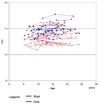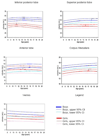Cerebellum development during childhood and adolescence: a longitudinal morphometric MRI study
- PMID: 19683586
- PMCID: PMC2775156
- DOI: 10.1016/j.neuroimage.2009.08.016
Cerebellum development during childhood and adolescence: a longitudinal morphometric MRI study
Abstract
In addition to its well-established role in balance, coordination, and other motor skills, the cerebellum is increasingly recognized as a prominent contributor to a wide array of cognitive and emotional functions. Many of these capacities undergo dramatic changes during childhood and adolescence. However, accurate characterization of co-occurring anatomical changes has been hindered by lack of longitudinal data and methodologic challenges in quantifying subdivisions of the cerebellum. In this study we apply an innovative image analysis technique to quantify total cerebellar volume and 11 subdivisions (i.e. anterior, superior posterior, and inferior posterior lobes, corpus medullare, and three vermal regions) from anatomic brain MRI scans from 25 healthy females and 25 healthy males aged 5-24 years, each of whom was scanned at least three times at approximately 2-year intervals. Total cerebellum volume followed an inverted U shaped developmental trajectory peaking at age 11.8 years in females and 15.6 years in males. Cerebellar volume was 10% to 13% larger in males depending on the age of comparison and the sexual dimorphism remained significant after covarying for total brain volume. Subdivisions of the cerebellum had distinctive developmental trajectories with more phylogenetically recent regions maturing particularly late. The cerebellum's unique protracted developmental trajectories, sexual dimorphism, preferential vulnerability to environmental influences, and frequent implication in childhood onset disorders such as autism and ADHD make it a prime target for pediatric neuroimaging investigations.
Figures


 Boys
Boys  Girls Observations from one individual are connected by lines
Girls Observations from one individual are connected by lines
 Boys —— Boys, upper 95% CI
Boys —— Boys, upper 95% CI  Boys, lower 95% CI
Boys, lower 95% CI  Girls
Girls  Girls, upper 95% CI
Girls, upper 95% CI  Girls, lower 95% CI
Girls, lower 95% CI  Indicates age of peak volume
Indicates age of peak volume
 Boys —— Boys, upper 95% CI
Boys —— Boys, upper 95% CI  Boys, lower 95% CI
Boys, lower 95% CI  Girls
Girls  Girls, upper 95% CI
Girls, upper 95% CI  Girls, lower 95% CI
Girls, lower 95% CI  Indicates age of peak volume
Indicates age of peak volumeSimilar articles
-
Typical development of basal ganglia, hippocampus, amygdala and cerebellum from age 7 to 24.Neuroimage. 2014 Aug 1;96:67-72. doi: 10.1016/j.neuroimage.2014.03.072. Epub 2014 Apr 4. Neuroimage. 2014. PMID: 24705201
-
Emotional and behavioral problems change the development of cerebellar gray matter volume, thickness, and surface area from childhood to adolescence: A longitudinal cohort study.CNS Neurosci Ther. 2023 Nov;29(11):3528-3548. doi: 10.1111/cns.14286. Epub 2023 Jun 8. CNS Neurosci Ther. 2023. PMID: 37287420 Free PMC article.
-
Sexual dimorphism of brain developmental trajectories during childhood and adolescence.Neuroimage. 2007 Jul 15;36(4):1065-73. doi: 10.1016/j.neuroimage.2007.03.053. Epub 2007 Apr 6. Neuroimage. 2007. PMID: 17513132 Free PMC article.
-
Conventional MRI.Handb Clin Neurol. 2018;154:219-234. doi: 10.1016/B978-0-444-63956-1.00013-8. Handb Clin Neurol. 2018. PMID: 29903441 Review.
-
Consensus Paper: Cerebellum and Ageing.Cerebellum. 2024 Apr;23(2):802-832. doi: 10.1007/s12311-023-01577-7. Epub 2023 Jul 10. Cerebellum. 2024. PMID: 37428408 Free PMC article. Review.
Cited by
-
The effect of bilingualism on brain development from early childhood to young adulthood.Brain Struct Funct. 2020 Sep;225(7):2131-2152. doi: 10.1007/s00429-020-02115-5. Epub 2020 Jul 20. Brain Struct Funct. 2020. PMID: 32691216 Free PMC article.
-
Childhood maltreatment is associated with altered frontolimbic neurobiological activity during wakefulness in adulthood.Dev Psychopathol. 2016 May;28(2):551-64. doi: 10.1017/S0954579415000589. Epub 2015 Jul 22. Dev Psychopathol. 2016. PMID: 26198818 Free PMC article.
-
Multi-aspect testing and ranking inference to quantify dimorphism in the cytoarchitecture of cerebellum of male, female and intersex individuals: a model applied to bovine brains.Brain Struct Funct. 2020 Dec;225(9):2669-2688. doi: 10.1007/s00429-020-02147-x. Epub 2020 Sep 28. Brain Struct Funct. 2020. PMID: 32989472 Free PMC article.
-
Performance monitoring in children and adolescents: a review of developmental changes in the error-related negativity and brain maturation.Dev Cogn Neurosci. 2013 Oct;6:1-13. doi: 10.1016/j.dcn.2013.05.001. Epub 2013 May 13. Dev Cogn Neurosci. 2013. PMID: 23777674 Free PMC article. Review.
-
Developmental change in predictive motor abilities.iScience. 2023 Jan 25;26(2):106038. doi: 10.1016/j.isci.2023.106038. eCollection 2023 Feb 17. iScience. 2023. PMID: 36824276 Free PMC article.
References
-
- Achenbach TM, Edelbrock CS. Manual for child behavior checklist and revised behavior profile. Burlington, VT: Department of Psychiatry, University of Vermont; 1983.
-
- Bishop DV. Cerebellar abnormalities in developmental dyslexia: cause, correlate or consequence? Cortex. 2002;38:491–498. - PubMed
-
- Caviness VS, Jr, Kennedy DN, Richelme C, Rademacher J, Filipek PA. The human brain age 7–11 years, A volumetric analysis based on Magnetic Resonance Images. Cerebral Cortex. 1996;6:726–736. - PubMed
-
- Chechik G, Meilijson I, Ruppin E. Neuronal regulation: A mechanism for synaptic pruning during brain maturation. Neural Comput. 1999;11:2061–2080. - PubMed
Publication types
MeSH terms
Grants and funding
LinkOut - more resources
Full Text Sources

